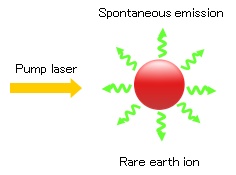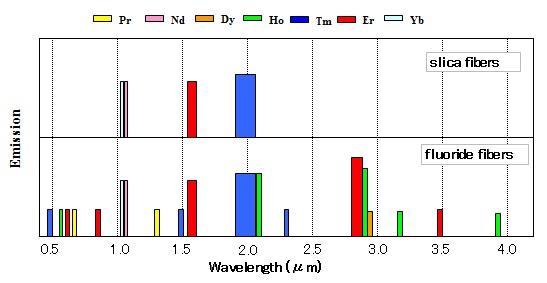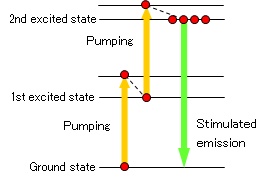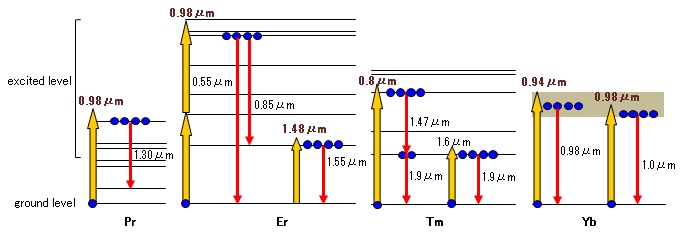Last updated on 05/7/2021
ASE light source is one type of optical light sources, where the emission is generated by Amplified Spontaneous Emission. An optical gain medium emits light spontaneously when it is optically/electrically pumped, and if the pumping of the gain medium is strong enough, the “spontaneous” emission is amplified via the “stimulated” emission – this phenomenon is called Amplified Spontaneous Emission.
ASE light sources generally possess broadband spectrum and low coherence, and have been used in various optical measurement and sensing systems, such as FBG sensing, OCT, fiber optic gyroscopes, gas sensing, measurement of optical components, and so on.
In particular, ASE light sources made by rare-earth-doped optical fiber (RE-doped optical fiber) are widely used due to the following reasons: (1) ASE is generated in the fiber core, and therefore can be coupled to a single mode fiber with a very low coupling loss, (2) the core of an optical fiber is usually circular thus the output is inherently unpolarized, (3) the emission from a RE-doped optical fiber is generally very broad, resulting in a very broadband light source.
ASE from a RE-doped optical fiber is generated in a similar way as fiber lasers and fiber amplifiers. Indeed, “fiber lasers below threshold” and “fiber amplifiers with no signal input” are both ASE sources.
Figure 1 shows a schematic of spontaneous emission from a rare-earth ion. A rare-earth ion absorbs the pump light and spontaneously emits light at a different wavelength from that of the pump light.

Figure 1: Spontaneous emission from rare earth ion.
Figure 2 schematically shows spontaneous emission and stimulated emission. When the pump intensity is increased enough, the initial spontaneous emission is amplified by stimulated emission and the optical power increases. The stimulated emission requires strong excitation of the gain medium, such that the number of electrons at the excited level exceeds the number of electrons at the ground state. This is called population inversion.

Figure 2: Spontaneous emission and stimulated emission.
Creating population inversion in a RE-doped optical fiber is relatively easy, because an optical fiber confines light in a very small core (typically less than 10 microns) and thus the pump intensity in the core is very high. This feature makes stimulated emission process in a RE-doped optical fiber highly efficient. RE-doped optical fibers are therefore often used to make ASE light sources, fiber lasers, and optical fiber amplifiers.
Figure 3 schematically shows how ASE grows in a RE-doped fiber and is extracted from a fiber endface. When pump laser is launched into the core of a RE-doped fiber, light generated by spontaneous emission is amplified by stimulated emission. The amplification occurs along the entire length of the fiber and the power grows as the light travels through the fiber, and as a result, high intensity ASE light is extracted from the fiber end. Note that, even though the stimulated emission is a coherent process, the coherence of ASE sources is very low because spontaneous emission occurs at any position along the fiber and thus is incoherent.

Figure 3: Spontaneous emission is amplified by stimulated emission before the light is extracted. Though the arrows in the figure (ASE light and pump light) are drawn outside the core, the both lights pass through the core.
Emission wavelengths from a RE-doped optical fiber are largely determined by the rare-earth material. This is because the emission from a rare-earth ion occurs when the rare-earth ion is excited to a certain upper energy level and then drops to another lower energy level, and the energy levels are specific to the rare-earth material. The emission wavelengths, however, also depend on fiber material (host glass), as in some host glass material, radiation of energy from an excited rare-earth ion is more likely to take a form of thermal energy, and emission becomes extremely poor.
Figure 4 shows the emission wavelengths from various rare-earth materials doped in a silica and fluoride fiber. Fluoride fiber emits light at a larger number of wavelengths, as the thermal radiation process is much less in fluoride fiber than in silica fiber. In particular, emission at the O-band (1310 nm) from Praseodymium (Pr) and emission at the S-band (1480 nm) from Thulium (Tm) do not occur using silica glass as the host glass, making fluoride fiber indispensable for the O-band and S-band fiber ASE sources. On the other hand, emission at the C-band and L-band (1530 – 1625 nm) from Erbium (Er) occurs both in silica and fluoride fiber, and most fiber ASE sources at these wavelengths use Er-doped silica fiber.

Figure 4: Emission wavelengths in fluoride fibers and silica fibers.
Another unique feature of a fluoride fiber is capability to emit the light at shorter wavelengths than the pump light wavelength. This is because the electrons excited to the first excited level is further excited to the second excited level as shown in Fig.5. This phenomenon is also attributable to the nature of fluoride fibers that enrgy of the excited electron is less likely to be converted into thermal energy. FiberLabs offers an ASE light source of a variety of wavelength bands by using the rare earth-doped fluoride fiber. The relationship between the emission wavelengths and the energy diagram is shown in Fig.6.

Figure 5: Two step excitation in fluoride fibers.

Figure 6: Relationship between energy diagrams and emission wavelengths of ASE light sources.
FiberLabs offers the following products related to this article. Please visit these pages if you are interested in this article.